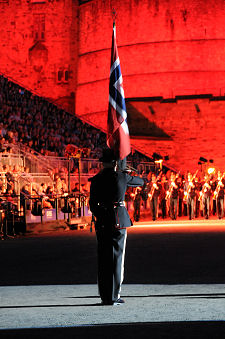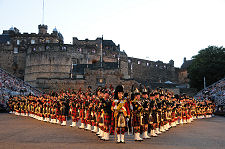 The Royal Edinburgh Military Tattoo Celebrates HM The Queen's Diamond Jubilee: More Tattoo Images |
The Royal Edinburgh Military Tattoo began life in 1950 as the Army's contribution to the Edinburgh International Festival, then three years old. The programme comprised just eight items and in the first year there were no stands: the audience watched from the Esplanade itself. Stands for spectators first appeared the following year, but have grown very considerably since. New stands, first used in 2011, can accommodate 8,600 spectators in considerably more comfort than their 35 year old predecessors.
Over the years the Edinburgh Tattoo has gained a reputation for excellence and spectacle that is unmatched anywhere. A typical reaction of first time visitors was that of the Taiwanese lady journalist we met at the 2012 Tattoo: "It makes your spine tingle!"
The first overseas participants in the Tattoo were the Band of the Royal Netherlands Grenadiers in 1952, and since then some 46 countries from all parts of the globe have taken part. On average, there are around 1000 participants in the Tattoo each year. And if the cast list is truly international, so is the audience. Of about 220,000 people who see the Tattoo live each year, some 70% come from outwith Scotland, and of them half are from overseas. A further 100 million watch it each year on TV around the world. What was previously know as the Edinburgh Military Tattoo was granted the right to be called the Royal Edinburgh Military Tattoo by HM the Queen in 2010.
The tattoo reflects a military tradition that dates back centuries, to an age when the pipes and drums of regiments stationed in the Low Countries marched through the local town each evening to signal to soldiers that it was time to return to barracks. The word "tattoo" itself is thought to come from the Dutch "doe den tap toe" meaning it was time for innkeepers to "turn off the (beer) taps".
For the audience, the experience begins with the walk up Castle Hill towards the bulk of the stands that loom over the Castle Esplanade. The process of getting some 8,600 people into their seats is as slick and well rehearsed as the show itself. Normal performances of the Tattoo are timed to allow full appreciation of the last of the post-sunset light, silhouetting the imposing bulk of Edinburgh Castle. Catch it on the right day and this can itself add dramatically to the spectacle of the event. Catch it on the wrong day and waterproofs are essential, though the weather is never too bad for the participants: no performance of the Tattoo has ever been cancelled.
The programme for the Tattoo varies from year to year. Most of the images on this page show the 2012 Tattoo, while those on the additional page of Tattoo images were taken at the 2003, 2008 and 2010 shows. Some elements of the Tattoo are constant from year to year. The massed pipes and drums of the British armed forces, usually incorporating guests from many different parts of the world, are at the core of any Tattoo. And the show always features a lone piper located high on the battlements of Edinburgh Castle.
Other elements vary from year to year. The 2003 Tattoo, for example, included spectacular displays performed by the Royal Signals Motorcycle Display Team, the White Helmets, and by the King's Troop, Royal Horse Artillery. In 2008 there was more focus on music and on marching bands. 2010 marked the Tattoo's Diamond Jubilee Year. Participants came from far and wide, including the Polish and Jordanian armies, plus the Imps Motorcycle Display Team and a gymnastics display. The highlight for us was a superbly entertaining performance by the New Zealand Army Band incorporating a highly enthusiastic Haka.
The 2012 Tattoo was a celebration of HM The Queen's Diamond Jubilee. This was reflected in the diamond formation of the massed pipes and drums early in the performance, and by a musical re-enactment of the Coronation, complete with magnificent projections onto the castle, during the finale. Overseas participants included the Band of the Australian Defence Force; OzScot Australia dance troupe; the United States Naval Forces Europe Band; Switzerland's Top Secret Drum Corps; and the King of Norway's Guards Band and Drill Team. Amongst other items on the programme were Pictish Warriors playing the Carynx; a celebration of Scotland's whisky industry in music and dance; and a segment moving from standing stones to Scotland's industrialisation accompanied by music from the film "Brave".
The changes from year to year ensure the Tattoo never becomes stale and help ensure that many people return time after time. At the end of each show the Finale brings onto the Esplanade all the performers from that night's event for a climax that includes the taking of the salute. Participants then march down Castlehill to embark on coaches that take them back to their barracks before the spectators follow them.
No description, no set of images, and no TV presentation can possibly do justice to the true Tattoo experience. Location, atmosphere and stunning performance combine to form an unforgettable evening's spectacle.
If you want to see for yourself, be warned: tickets start to sell out quickly once they go on sale the preceding December. See the Tattoo's own website, linked from the Visitor Information section of this page, for further information.
 Pictish Warrior |
 The Massed Pipes and Drums |
 King of Norway's Guards Flagbearer |
 Cruachan III, Regimental Mascot |

|
|
|
Visitor InformationView Location on MapRoyal Edinburgh Military Tattoo: 2024 Dates: 2-24 August 2024. Tattoo Office, 1-3 Cockburn Street, Edinburgh, EH1 1QB. Tel: 0131 225 1188. tickets@edintattoo.co.uk www.edintattoo.co.uk More Tattoo Images What3Words Location: ///agents.caller.cycles |
 The Massed Pipes and Drums... |
 ...In Diamond Formation |
 Band of the Royal Marines |
 Music Inspired by the Film Brave |
 Massed Highland Dancers |
 Australian Defence Force Band |
 Top Secret Drum Corps |
 King of Norway's Guards Band |
 Participants Leaving the Tattoo |
 Participants Leaving the Tattoo |











